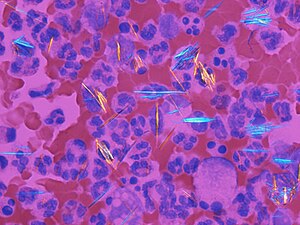Crystals in body fluids
Jump to navigation
Jump to search

The printable version is no longer supported and may have rendering errors. Please update your browser bookmarks and please use the default browser print function instead.

Crystals (gout) and blood cells in polarized light. (WC/Gabriel Caponetti)
This article deals with crystals in body fluids.
Crystals
Joint crystals
Types:[1]
- Gout = needle-shaped, negatively birefringent, yellow when aligned.
- Pseudogout = rhomboid-shaped, positively birefringent, blue when aligned.
Notes:
- Pseudogout also known as CPPD = calcium pyrophosphate dehydrogenase.
- Memory device: ABC+ = aligned blue is calcium & cuboid - positively birefringent.
Urine crystals
Types - morphology:
- Envelope shape (calcium oxalate).
- Diamond shape (uric acid).
- Coffin-lid shape (struvite).
- Hexagonal shape (cysteine).
Notes:
- Memory devices:
- Diamonds are see-through; ergo, uric acid stones not seen on KUB.
- Calcium oxalate = envelope, uric acid = diamond.
- Uric acid crystals: usually dissolve in formalin... but do not dissolve in alcohol.[2][3]
- Calcium oxalate crystals are seen in the context of ethylene glycol poisoning.[4]
Images
Case
www
Sign out
Urine cytology
Negative for malignant cells. Mainly squamous cells present. Cuboidal/rhomboidal crystals present.
Diseases
Gout
Main article: Gout
Pseudogout
Main article: Chondrocalcinosis
See also
- Cytopathology.
- Medical renal diseases.
- Nephrolithiasis - kidney stones.
- Polarized light.
References
- ↑ Yeung, J.C.; Leonard, Blair J. N. (2005). The Toronto Notes 2005 - Review for the MCCQE and Comprehensive Medical Reference (2005 ed.). The Toronto Notes Inc. for Medical Students Inc.. pp. RH6. ISBN 978-0968592854.
- ↑ Geddie, W. 8 January 2010.
- ↑ Shidham, V.; Chivukula, M.; Basir, Z.; Shidham, G. (Aug 2001). "Evaluation of crystals in formalin-fixed, paraffin-embedded tissue sections for the differential diagnosis of pseudogout, gout, and tumoral calcinosis.". Mod Pathol 14 (8): 806-10. doi:10.1038/modpathol.3880394. PMID 11504841.
- ↑ Saukko, Pekka; Knight, Bernard (2004). Knight's Forensic Pathology (3rd ed.). A Hodder Arnold Publication. pp. 589. ISBN 978-0340760444.
- ↑ URL: http://www.ncbi.nlm.nih.gov/pubmedhealth/PMH0001458/. Accessed on: 28 October 2011.









